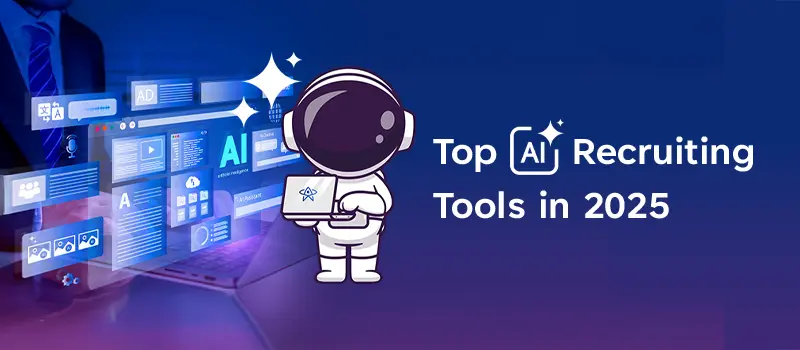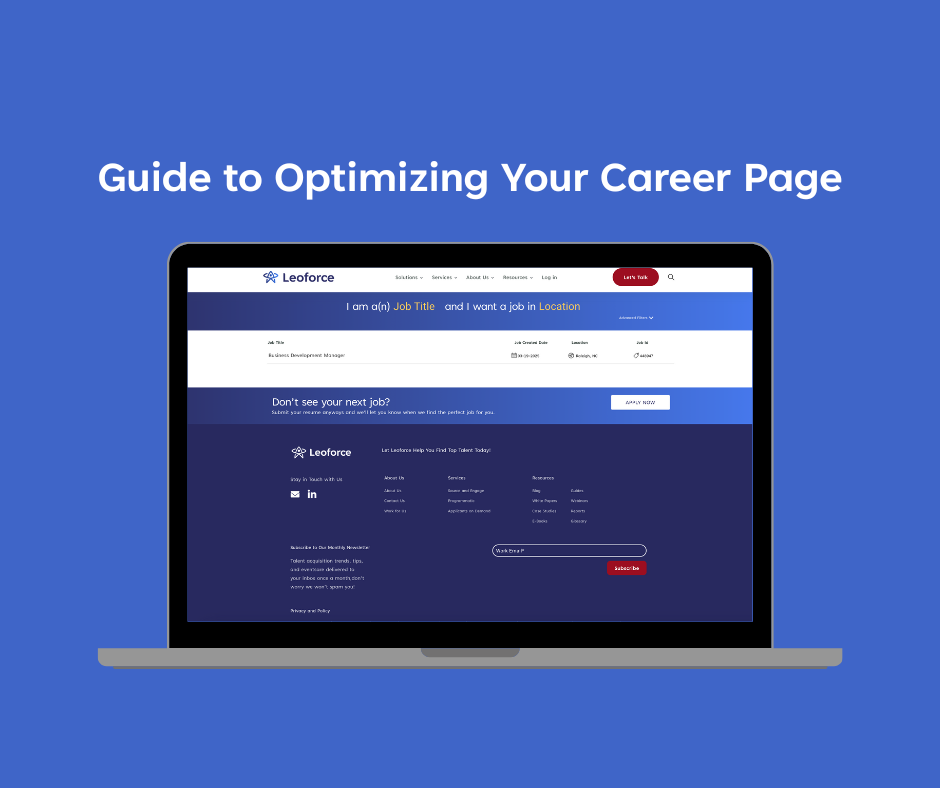The Future of Recruitment: Automating Candidate Sourcing in 2024

With a value soaring to $590.5 billion in 2023 and projected growth to reach $942.3 billion by 2030, there is no doubt that the AI recruitment industry is skyrocketing. In this dynamic landscape, the significance of automating candidate sourcing, as part of the evolving job market of 2024, cannot be overstated. Organizations are compelled to embrace technological advancements to stay competitive in the rapidly evolving job market.
Recruitment automation not only addresses the demands of the industry but also offers substantial benefits, including time savings, efficiency improvements, and an enhanced candidate experience. As we delve into the 2024 recruitment trends shaping the industry, it becomes evident that harnessing the power of automation is no longer a choice but a strategic imperative for organizations striving to thrive in the digital age. Close to 70% of organizations globally are adopting AI and automation solutions for recruitment tasks including candidate sourcing. Let’s understand strategies to make the most of automation solutions to optimize candidate sourcing.
Leverage automated job boards
Automated job boards offer a streamlined approach to expand reach and simplify the posting process. These platforms, such as LinkedIn, Indeed, and Glassdoor, enable recruiters to automate the posting of job openings across multiple channels simultaneously. By leveraging automated job postings, organizations can save valuable time and effort while ensuring maximum visibility for their vacancies.
To set up automated postings, recruiters typically create an account on the preferred job board platform, upload job descriptions, and configure posting schedules. Additionally, many platforms offer features like job ad optimization and targeted audience segmentation to enhance recruitment effectiveness further.
Harnessing social media platforms, particularly LinkedIn, for candidate searches can revolutionize recruitment processes. LinkedIn automated searches allow recruiters to efficiently sift through vast networks to find suitable candidates. Leveraging advanced search filters enables recruiters to narrow down their search criteria based on specific skills, experience, location, and more, thus streamlining the candidate selection process.
Additionally, setting up automated alerts notifies recruiters of new candidates matching their criteria, ensuring they stay updated on potential talent without manual effort. Social media recruitment offers a dynamic approach to sourcing candidates, tapping into a diverse pool of professionals across industries and geographies. By maximizing the capabilities of platforms like LinkedIn for automated searches and utilizing advanced search filters, organizations can enhance their recruitment strategies, optimize candidate sourcing, and stay ahead in the competitive talent market.
Implement CRM systems for outreach
Incorporating candidate relationship management (CRM) systems into recruitment processes is essential for automating communication and nurturing relationships with potential candidates. These systems allow recruiters to streamline outreach efforts by automating personalized emails, follow-ups, and reminders, ensuring consistent engagement throughout the candidate lifecycle.
Features such as automated email campaigns and activity tracking enable recruiters to maintain a structured approach to candidate communication, track interactions, and tailor engagement strategies based on candidate preferences and behaviors.
By leveraging CRM systems, organizations can not only enhance efficiency in candidate outreach but also cultivate stronger relationships, leading to improved candidate experiences and increased likelihood of successful placements. CRM in recruitment facilitates seamless automation of outreach activities, fostering meaningful connections with candidates and ultimately contributing to more effective talent acquisition strategies.
Integrate sourcing tools for resume parsing
Automated sourcing tools play a crucial role in simplifying resume parsing and skill extraction, thereby accelerating the candidate screening process. These tools utilize advanced algorithms to automatically extract relevant information from resumes, such as qualifications, experience, and skills, saving recruiters significant time and effort. By integrating such tools into recruitment processes, organizations can streamline candidate evaluation and selection, leading to faster hiring decisions and reduced time-to-fill.
Leading tools in this space offer benefits such as intelligent parsing capabilities, which accurately extract key information from resumes, and customizable filters that enable recruiters to prioritize specific skills or qualifications. By leveraging automated resume parsing and skill extraction tools, organizations can optimize their candidate screening processes, identify top talent more efficiently, and ultimately improve the overall recruitment experience for both candidates and hiring teams.
Employ Programmatic search for developer profiles
Employing Programmatic search queries enables recruiters to automatically find developer profiles across various platforms, streamlining the process of identifying top talent in the tech industry. This allows recruiters to efficiently target specific skills and programming languages, ensuring that candidate searches are tailored to the requirements of the role.
This approach not only enhances the efficiency of candidate sourcing but also increases the likelihood of identifying candidates with the exact skill sets needed for the job. Programmatic search queries enable recruiters to cast a wider net and uncover hidden talent across platforms and specialized developer communities. By leveraging targeted skill searches, organizations can identify and engage with developer profiles that match their specific requirements, ultimately leading to more successful hires and improved team performance.
Set up automated email drip campaigns
Setting up automated email drip campaigns is an effective strategy for nurturing candidate leads and maintaining consistent communication throughout the recruitment process. These campaigns allow recruiters to deliver personalized messages to candidates at predefined intervals, keeping them engaged and informed about job opportunities and company updates.
To set up automated email drip campaigns, recruiters begin by segmenting their candidate database based on criteria such as skills, experience, and job preferences. Next, they craft a series of targeted emails tailored to each segment, focusing on providing valuable content, such as industry insights, career tips, and company culture highlights. The key to ensuring that candidates feel valued and engaged is personalization, so emails should address recipients by name and speak directly to their interests and aspirations.
Timing also plays a crucial role in the effectiveness of email drip campaigns. Recruiters need to strategically schedule emails to coincide with key milestones in the candidate journey, such as after initial contact, following an interview, or when new job opportunities arise.
Utilize chatbots for candidate inquiries
Employing chatbots for candidate inquiries plays a pivotal role in streamlining recruitment processes by efficiently handling basic inquiries and pre-screening applicants. Chatbots serve as virtual assistants, engaging with candidates in real-time to provide information about job openings, application procedures, and company culture. Additionally, they facilitate pre-screening by asking candidates predefined questions to assess their qualifications and fit for the role.
The implementation process for chatbots involves selecting a suitable platform or building a custom solution tailored to the organization’s needs. Once deployed, chatbots can be integrated into the careers page of the company website, social media channels, or messaging platforms.
Recruitment chatbots enhance candidate engagement, provide instant support, and ensure a seamless experience throughout the recruitment journey, ultimately contributing to a more efficient and effective hiring process.
Integrate skills assessment platforms
Integrating skills assessment platforms into the recruitment process offers numerous benefits by automating testing and verifying candidates’ skills efficiently. These platforms enable recruiters to assess candidates’ proficiency in specific skills and competencies relevant to the job role through various types of assessments, including coding challenges, technical quizzes, and behavioral assessments.
One of the key benefits of using automated skills assessment platforms is the ability to objectively evaluate candidates based on standardized criteria, ensuring fairness and consistency in the hiring process. Additionally, automated testing streamlines the assessment process, allowing recruiters to quickly identify top performers and make data-driven hiring decisions.
Leverage automated interview scheduling
Utilizing automated interview scheduling tools streamlines the coordination of interviews, alleviating administrative burdens for recruiters and candidates alike. These tools offer features such as calendar integration, allowing recruiters to view availability and schedule interviews without the need for manual coordination. Candidates can also input their preferences and availability directly into the system, further simplifying the scheduling process and reducing back-and-forth communication.
Furthermore, automated tools can send reminders and notifications to both recruiters and candidates, reducing the likelihood of missed appointments and improving overall communication throughout the interview process.
Promote positions internally with automation
Automating the internal promotion of open positions can significantly boost employee referrals and streamline the recruitment process. By leveraging automation tools, organizations can proactively notify existing employees about job openings that match their skills and interests, encouraging them to refer qualified candidates from their network.
Implementing employee referral programs with incentives further incentivizes employees to participate in the recruitment process. These programs typically offer rewards or bonuses to employees who refer candidates that are successfully hired, fostering a culture of internal mobility and engagement.
Automated referral programs streamline the referral process by allowing employees to easily submit referrals through designated platforms or portals. Recruiters can then track and manage referrals efficiently, ensuring timely follow-ups and acknowledgment of employee contributions.
Utilize web scraping tools for profile extraction
Utilizing specialized web scraping tools enables recruiters to automatically extract candidate profiles and contact information from various online platforms, streamlining the sourcing process. These tools can gather data from sources such as professional networking sites, job boards, and social media platforms, providing recruiters with a comprehensive pool of potential candidates.
Recruiters should also ensure that they are compliant with relevant regulations and obtain consent from candidates before extracting their information in adherence with data privacy guidelines when employing web scraping for recruitment purposes. Additionally, it’s crucial to use web scraping tools responsibly, respecting the terms of service of the platforms being scraped and refraining from activities that could harm the user experience or violate platform policies.
Leverage AI for candidate suggestion
Leveraging AI-driven tools for candidate suggestion revolutionises the recruitment process by providing highly accurate matches based on skills and experiences found in resumes or online profiles. These tools analyze job descriptions and candidate profiles, utilizing machine learning algorithms to identify and rank candidates who closely align with the job requirements.
The implementation of AI-driven candidate suggestion tools involves integrating them into existing applicant tracking systems (ATS) or recruitment platforms. Recruiters can input job descriptions into the system, and AI algorithms automatically scan through candidate databases or external sources to suggest the most suitable candidates.
Automate candidate outreach via SMS
Automating candidate outreach via SMS offers an effective means of immediate communication, particularly for roles requiring quick fill times. Text messages have a high open rate and are often read within minutes of being received, making them an efficient channel for reaching candidates in a timely manner.
Using automated text messages allows recruiters to quickly notify candidates about job opportunities, interview invitations, or application status updates. For roles requiring immediate fill, such as temporary or urgent positions, SMS outreach can expedite the recruitment process and ensure timely responses from candidates. Automating candidate outreach via SMS allows organizations to enhance candidate engagement, streamline communication, and accelerate the hiring process for roles that require immediate fill.
Engage passive candidates with retargeting ads
Setting up retargeting campaigns involves creating customized ads and defining targeting parameters based on user behavior. Recruiters can segment audiences based on their interactions with the careers page, job listings, or other relevant content, ensuring that retargeting ads are tailored to each group’s interests and preferences.
Retargeting for recruitment campaigns can be implemented across various platforms, including social media, display networks, and search engines. Social media platforms like Facebook, LinkedIn, and Twitter offer robust retargeting capabilities, allowing recruiters to display ads to passive candidates as they scroll through their feeds or visit related pages.
By leveraging retargeting for recruitment, organizations can engage passive candidates, reinforce brand awareness, and encourage them to revisit the careers page or consider new job opportunities. This recruitment marketing strategy enhances candidate engagement, expands the talent pool, and ultimately contributes to a more effective hiring process.
Search existing talent databases with ATS/CRM
Utilizing advanced Applicant Tracking Systems (ATS) or CRM software enables recruiters to automatically search through existing talent databases for candidates who may be a fit for new positions. These systems leverage sophisticated search algorithms to analyze candidate profiles, resumes, and application histories, identifying individuals whose skills and qualifications align with current job openings.
The benefits of leveraging past applicant pools for current openings are manifold. First, it allows recruiters to tap into a pre-screened and qualified talent pool, reducing time-to-fill and recruitment costs. Secondly, it enables organizations to maintain relationships with past applicants, fostering a positive candidate experience and enhancing employer branding.
Lastly, leveraging past applicants demonstrates a commitment to talent pipeline management and supports diversity and inclusion efforts by ensuring equitable access to opportunities for all candidates.
Automate outreach to diverse communities
Automating outreach to diverse communities is crucial for supporting diversity and inclusion initiatives in recruitment. Specialized platforms can streamline the process of reaching out to diverse communities and organizations for specific roles, ensuring that job opportunities are accessible to candidates from all backgrounds. These platforms leverage advanced algorithms to identify and engage with diverse talent pools, including underrepresented groups such as women, minorities, and individuals with disabilities.
Effective strategies for automated community outreach include crafting inclusive job postings, participating in diversity-focused events and career fairs, and partnering with affinity groups and professional organizations. By embracing automation in outreach efforts, organizations can enhance their diversity and inclusion initiatives, attract a more diverse talent pool, and foster a culture of belonging and equity in the workplace.
Event-based sourcing with automated follow-up
Participating in tech conferences and meetups is crucial for sourcing candidates. Automation tools capture contact information and send follow-up emails post-event, enhancing candidate engagement. Organizations can set up automated systems by preparing personalized templates, segmenting candidate lists, implementing automated workflows, and integrating event data with CRM systems. By automating event-based sourcing and follow-up, recruiters maximize efficiency and build a pipeline of qualified talent.
Tips for setting up automated systems include:
Preparing personalized follow-up templates:
Craft customized email templates that acknowledge the event participation and express interest in further conversation.
Segmenting candidate lists:
Group candidates based on their interests, skills, or interactions during the event to tailor follow-up communications effectively.
Implementing automated workflows:
Set up automated workflows to schedule follow-up emails at predefined intervals, ensuring timely and consistent communication with candidates.
Integrating event data with CRM systems:
Sync contact information and engagement data from events with CRM systems to track candidate interactions and nurture relationships effectively.
Monitor online platforms for potential candidates
Engaging with online communities and identifying potential candidates through their online activity is crucial for building relationships and attracting top talent. By actively participating in discussions, providing valuable insights, and offering assistance, recruiters can establish credibility and rapport within these communities, making them more likely to consider job opportunities with your organization.
To set up automated monitoring tools, recruiters must define specific keywords, job titles, or industry-related terms relevant to open positions. They must also consider configuring the tools to continuously scan online platforms for mentions of these keywords and receive real-time alerts or notifications when relevant discussions occur. Additionally, leverage advanced filters and search parameters to refine the results and focus on the most relevant conversations.
By monitoring online communities and leveraging automation tools for candidate identification, recruiters can stay informed about potential talent, proactively engage with candidates, and strengthen their employer brand within the tech community.
Conclusion
From leveraging automated job boards and CRM systems to utilizing AI for candidate suggestion and implementing event-based sourcing with automated follow-up, the possibilities for automation in recruitment are endless. These strategies enable recruiters to reach a wider pool of candidates, improve match accuracy, and reduce time-to-hire, leading to better hiring outcomes and enhanced candidate experiences.
Meet Leoforce by Leoforce
Leoforce by Leoforce is an innovative AI-powered recruitment platform that combines advanced automation with intelligent algorithms to revolutionize talent acquisition. Leoforce streamlines the recruitment process by automating candidate sourcing, engagement, and assessment, enabling recruiters to identify top talent quickly and efficiently. With its robust features and intuitive interface, Leoforce empowers companies to embrace recruitment automation and gain a competitive advantage in the 2024 job market.


